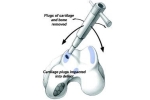OATS vs OCA for Cartilage Injuries of the Knee

We are often asked what is the difference between OATS and OCA. Here is a great overview provided by AAOS!
Osteochondral Autograft Transplantation
In osteochondral autograft transplantation, cartilage is transferred from one part of the joint to another.
The procedure, which can be done with an arthroscope or using an open approach, provides more durable hyaline cartilage to the defect area. A cylinder-shaped plug (graft) of healthy cartilage tissue and subchondral bone is taken from an area of the bone that does not carry weight (non-weightbearing). The graft is then matched to the surface area of the defect and pushed into place. This leaves a smooth cartilage surface in the joint.
A single plug of cartilage may be transferred, or the surgeon may perform a procedure using multiple plugs, called mosaicplasty.
Osteochondral autograft is used for smaller cartilage defects. This is because the healthy graft tissue can be taken only from a limited area of the same joint.
This procedure is also helpful when an MRI reveals that the bone under the cartilage defect shows signs of stress or wear.
Osteochondral Allograft Transplantation
If a cartilage defect is too large for an autograft, an allograft may be considered.
Like an autograft, an allograft is a graft composed of cartilage and bone. Allografts, however, are taken from a cadaver donor instead of the patient's own body. In the laboratory, the allograft tissue is sterilized, prepared, and tested for any possible diseases that might be transmitted to the recipient.
An allograft is typically larger than an autograft, but like autografts, allografts provide hyaline cartilage to the defect. The benefit of an allograft is that it can be shaped to fit the exact contour of the defect and then press fit into place.
Allografts are typically done through an open incision.
Please do not hesitate to contact us with any questions about cartilage surgery!







